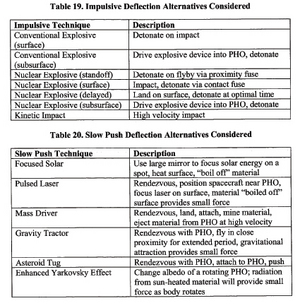To help sort through decades of scientific research and a century of science fiction, Iowa State university professor Bong Wie is establishing the first-ever Asteroid Deflection Research Center.
The Center will look at all available technologies that could be deployed to some day keep a space rock from slamming into the Earth and ending civilization.
"As of 2008, there is no consensus among professionals which approach or technology can be actually used when we have to use it," Wie told Wired.com. "So, therefore, we created this center to bring the experts from around the world together to [undertake] open-minded technical study."
Scientists believe the Earth has been hit several times by asteroids large enough to radically alter the planet. Sixty-five million years ago, a 6-mile-wide asteroid struck the Yucatan peninsula creating an enormous crater and probably leading to the extinction of most life on Earth at the time, including the dinosaurs. More recently, an 50-meter asteroid exploded just above the ground in Siberia with the force of 500 atomic bombs, leveling trees for miles around. Given the high stakes, Wie considers developing a strategy to push an asteroid off a collision path with Earth to be an underaddressed problem.
"No one is taking any responsibility for this problem," Wie said.
Still, in recent years, the threat from so-called near-Earth objects has received increasing scrutiny. NASA delivered a 137-page report to Congress on detecting and deflecting the objects, and the European Space Agency has planned a mission to intercept and impact an asteroid. The so-called Don Quijote mission plan is animated in the video.

|
| ©Unknown |
The NASA report summarizes the current deflection strategies to stop "potentially hazardous objects":
A wide range of deflection options were considered and evaluated. Perhaps the simplest of these is the kinetic impactor, where a spacecraft is collided with the PHO to change its orbit so that the object misses Earth. Detonating a conventional or nuclear explosive as part of the deflection effort can increase a kinetic impactor's effectiveness... In addition, a number of "slow push" techniques such as a space tug also were considered.The various specific alternatives are outlined in the table from the NASA report. The new Iowa State center will not focus on a specific technique.
"We will look at high-energy nuclear options as well as low-energy gravity tractor options," Wie said. "We are not biased in favor of any particular technique."
Wie stressed that blowing up or tugging asteroids was technically feasible. In fact, what seems most unrealistic about asteroid deflection is the idea that world governments would commit short-term money to a long-term, low-probability problem, even if ignoring the problem could have huge potential impacts. That's not exactly the average politician's M.O.



Reader Comments
to our Newsletter